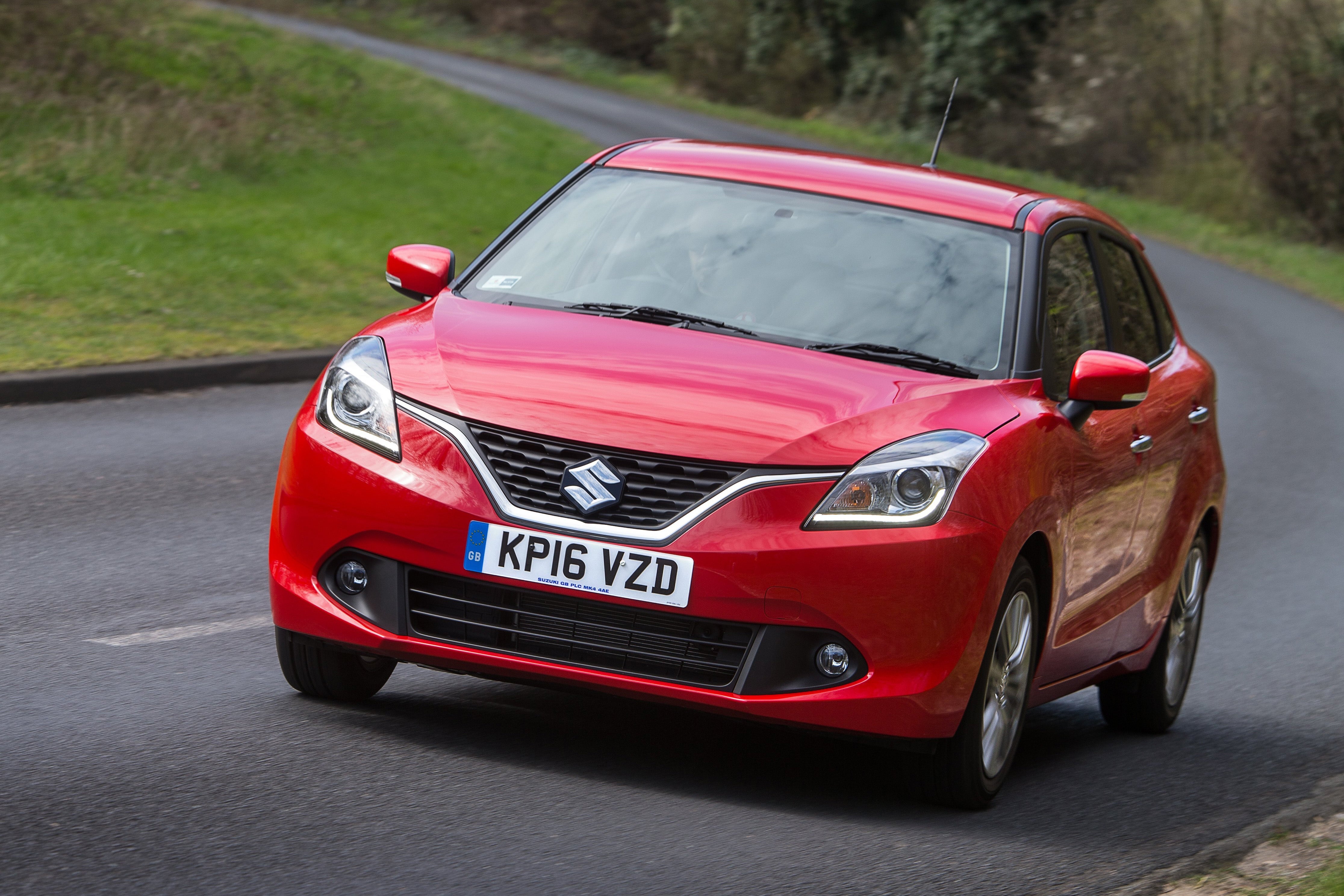Suzuki Baleno (2016-2019) Review
Quick overview
Pros
- Punchy and efficient petrol engines
- Excellent specification for the price
- More practical and spacious than the Swift
Cons
- Interior lacks quality
- Humdrum and forgettable styling
- No diesel option
Overall verdict
"The Suzuki Baleno is far from perfect, but don’t its the humdrum styling and absence of charm fool you, because this is an underrated gem. Not only is it good fun to drive, it comes with a long list of equipment and it will be cheap to run."
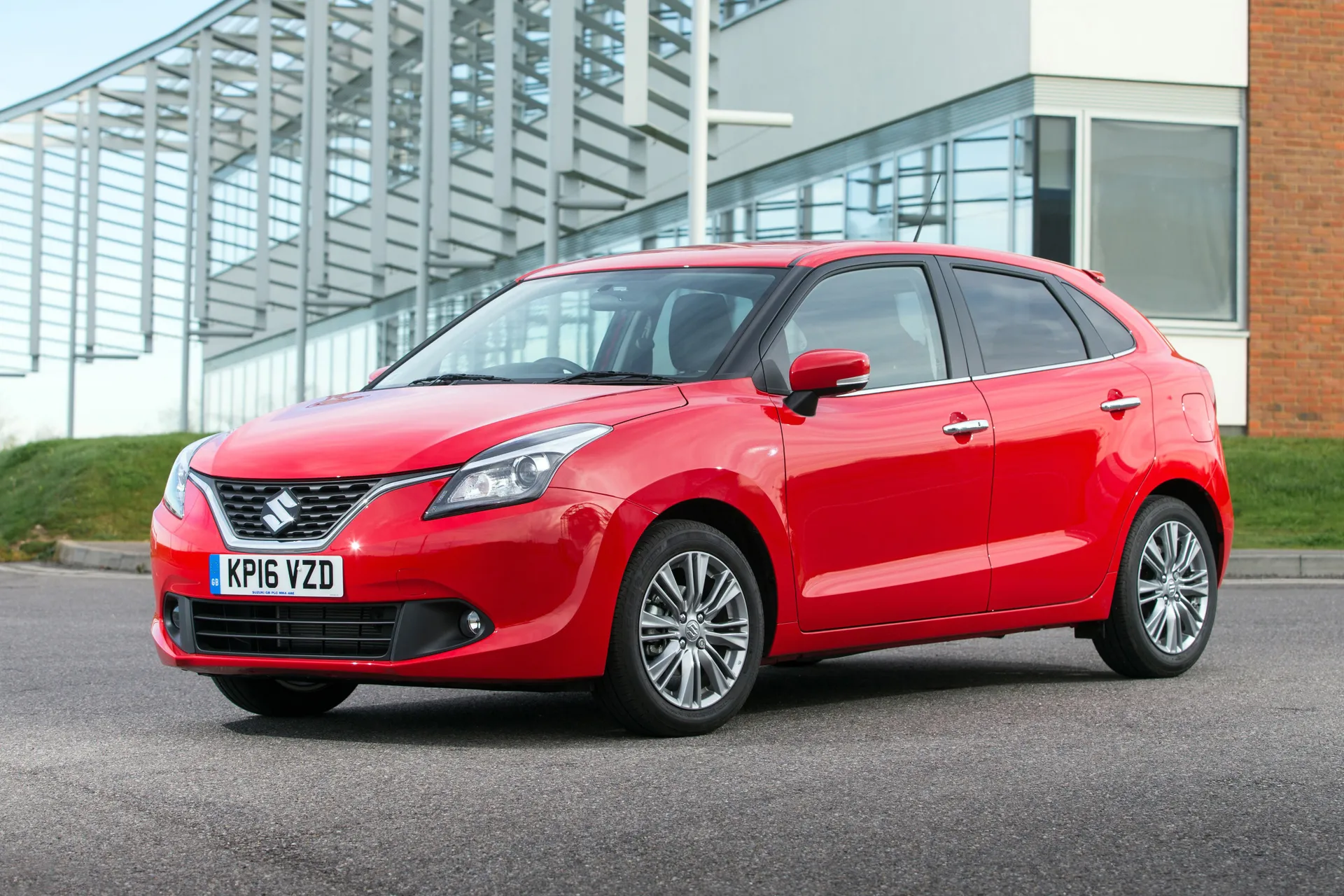
Suzuki put a lot of work into the Baleno. It’s based on what was then an all-new lightweight platform and it featured Suzuki’s first mild hybrid system. The 1.0-litre three-cylinder engine was also the second application of Suzuki’s brilliantly named Boosterjet technology.
Suzuki put a lot of work into the Baleno. It’s based on what was then an all-new lightweight platform and it featured Suzuki’s first mild hybrid system. The 1.0-litre three-cylinder engine was also the second application of Suzuki’s brilliantly named Boosterjet technology.
How did you reward Suzuki’s efforts? By totally ignoring the Baleno. Although the supersize supermini has enjoyed success on the global stage, it was largely bypassed in Europe, which led to its withdrawal in 2019.
It deserved better. Beneath the humdrum styling and drab cabin lies a surprisingly characterful car that offers exceptional value for money. If you’re struggling to place it in the market, it’s a more practical version of the Suzuki Swift, with a larger boot and enough room for five adults.
Because it’s so light – some versions tip the scales at just 935kg – the Baleno can make the most of its small petrol engines. The 1.0-litre Boosterjet engine is an absolute riot, giving the Baleno a terrific turn of pace to go with its agility and nimbleness. A 0-62mph time of 11.4 seconds for the manual version might not seem quick on paper, but it feels faster in practice.
There’s also a 1.2-litre non-turbocharged petrol engine which is available with the Smart Hybrid Vehicle by Suzuki (SHVS) mild hybrid technology. By using a separate electric motor for engine restarts, the SHVS delivers a modest improvement in efficiency. It’s not a proper hybrid, so we’d opt for the hugely enjoyable Boosterjet instead.
Dynamically, it’s a bit of mixed bag. It’s clear that Suzuki wanted to maintain some distance between the Baleno and the Swift. As a result, the Baleno majors on comfort and ease-of-use, rather than dynamic thrills. That’s not to say that the Baleno is unable to entertain. Show it a corner and it will handle it with a touch of body-roll and a huge dollop of grip.
Inside, the cabin is as dour as the exterior, with the dashboard looking like it was lifted straight outta the 1990s. It doesn’t help that the plastics feel cheap and scratchy, although there’s a sense that everything was built to last.
In the back, there’s enough room for three adults, while the boot is larger than you’ll find in most superminis. It falls somewhere between a supermini and a family hatchback, so the Baleno is the car to opt for if a lack of space was the only reason you didn’t buy a Suzuki Swift.
Standard equipment is fine on the entry-level version, but the mid-range and flagship models offer better value for money. Some of the kit fitted as standard would cost far more in a car with a premium badge, so there’s a real sense that you’re getting more for your money.
It’s a good car. It might lack the badge appeal or smart styling of many of its rivals, but the Baleno is one of the sector’s most underrated gems. It’s not too late to make the discovery.
Looking for a used car for sale? We've got 100s of Suzuki Approved Used Cars for Sale for you to choose from, including a wide range of Suzuki Baleno models for sale.
Is the Suzuki Baleno right for you?
If the Suzuki Swift isn’t practical enough for you, the Baleno could be just the ticket. In many ways it’s the more mature and grown-up version of the Swift, with the Baleno trading magic and sparkle for practicality and economy.
Technically it’s a supermini, but the Baleno rivals some cars from the class above in terms of boot space and rear-seat accommodation.
It’s also surprisingly good fun to drive, especially if you opt for the punchy and efficient 1.0-litre Boosterjet engine. You just have to put up with the rather drab styling and the questionable interior quality. But given the level of spec and the low prices, we think you’ll cope.
What’s the best Suzuki Baleno model/engine to choose?
Brilliant by name, brilliant by nature. The 1.0-litre Boosterjet engine sounds like one of those space rockets you drew as a child. Although it won’t take you to the moon and back, it does offer long-legged economy and a terrific turn of pace. It makes the Suzuki Baleno one of the gems of the supermini sector.
A 0-62mph time of 11.4 seconds doesn’t sound quick on paper, but it feels more rapid on the road. This is thanks in so small part to the Baleno’s low weight, with Suzuki’s supermini tipping the scales at less than 1,000kg.
In terms of trim level, we’d opt for the flagship SZ5. Not only do you get a terrific level of standard equipment, the car also features the safety kit required to achieve a four-star Euro NCAP safety rating. Without this, the Baleno is rated at just three stars for safety.
What other cars are similar to the Suzuki Baleno?
The most obvious rival to the Suzuki Baleno is the Suzuki Swift. It’s similar to its showroom sibling, but with the benefit of more space in the back and a larger boot.
It’s similar in style and format to the Honda Jazz and Nissan Note, in the respect that the practicality makes it a kind of supersize supermini. Although the Baleno cannot offer the flexibility of the Jazz, it offers better value for money.
Other rivals include the Dacia Sandero, Skoda Fabia, Ford Fiesta, Vauxhall Corsa, Hyundai i20, Kia Rio and Renault Clio.
Comfort and design
"If you thought the exterior styling was dull, wait until you see the inside. Actually, that’s a bit unfair, because the Suzuki Baleno features a refreshingly simple layout and a fuss-free dashboard."
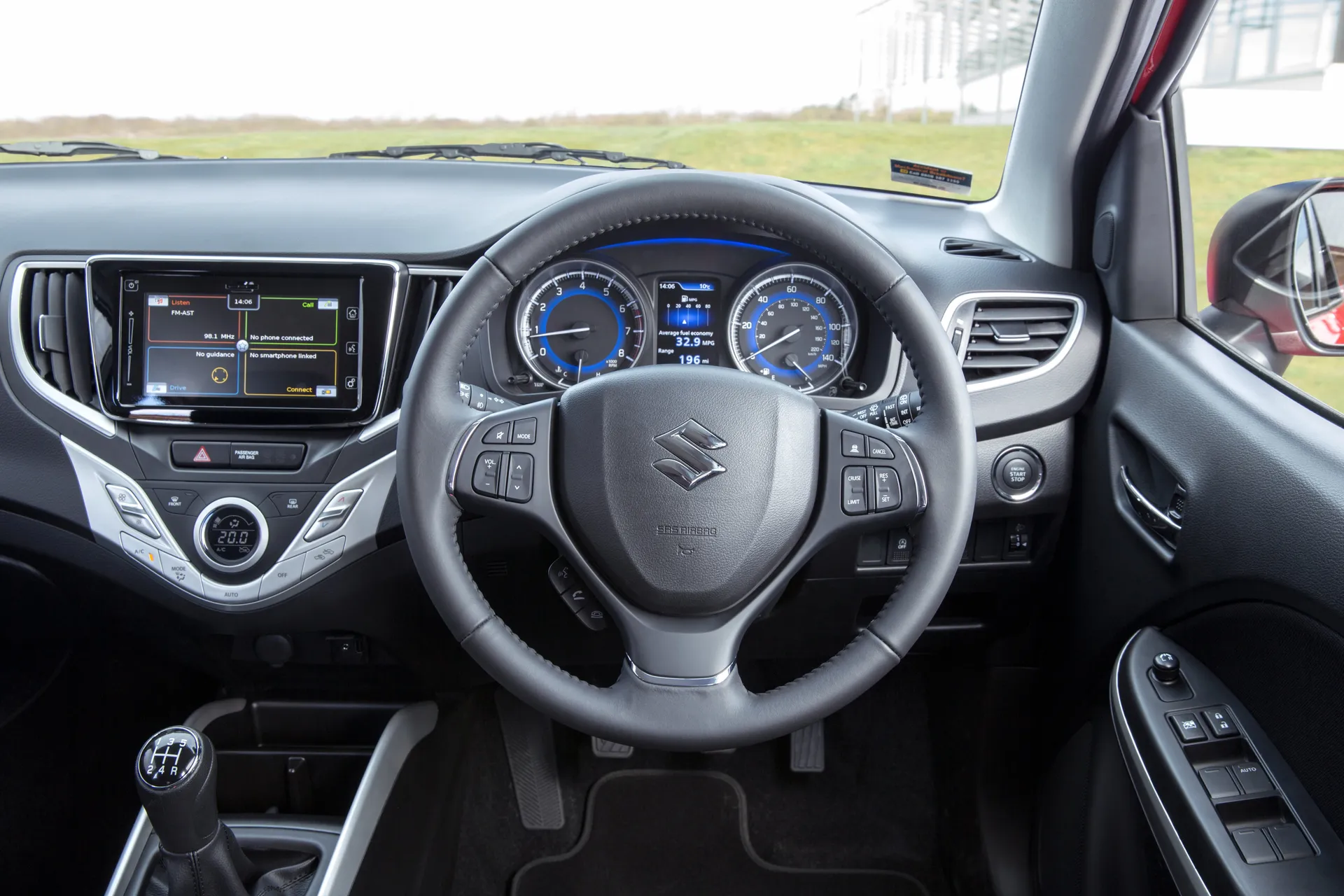
If you thought the exterior styling was dull, wait until you see the inside. Actually, that’s a bit unfair, because the Suzuki Baleno features a refreshingly simple layout and a fuss-free dashboard.
It majors on comfort, but although the seats feel comfortable initially, they don’t offer a huge amount of support on a long journey. There’s an overriding sense that you sit on the Baleno rather than in it.
The driver’s seat is adjustable for height, but although the steering wheel is adjustable for height across the range, only the top trim offers adjustment for reach. Still, there’s plenty of room for your feet, including a driver’s-side foot rest, which is useful on a motorway.
Manual air conditioning is fitted to all but the top trim level, with the system operated by a set of dials and buttons that wouldn’t look out of place in a car from the 1990s. The flagship Baleno boasts automatic climate control, but the silver finish and circular digital display look like they were lifted from a cheap hi-fi system from the same era.
The entry-level Baleno also gets a simple audio system comprising a CD player, DAB digital radio and Bluetooth. It’s basic in the extreme, but the large buttons and dials make it easy to operate on the move. All models feature audio controls on the steering wheel.
Other versions get a touchscreen infotainment system, which helps to add some interest to an otherwise drab dashboard. That said, it’s quite difficult to operate on the move, with no option to control the screen other than via the audio buttons on the steering wheel.
Quality and finish
Quality isn’t a Suzuki Baleno strong point. All of the plastics used in the cabin feel cheap and hollow, while the shiny finish reeks of something you might have found in a car from the… yes, you guessed it, the 1990s.
In common with other Suzuki models, it’s possible to gloss over the perceived lack of quality because the materials used are hard-wearing and the actual finish is perfectly acceptable. The design will never age because it was never in fashion.
The biggest problem is that some of the key touch points lack a premium feel. There isn’t a leather finish available for the gear knob or shift lever, but at least the steering wheel is leather-trimmed on all except the basic model.
The silver finish used for the climate control settings is bordering on nasty, while the flimsy controls for the odometer and screen brightness appear to have the structural rigidity of a Matchmaker chocolate stick.
All versions get a bizarre chrome strip running along the width of the tailgate, while the flagship model boasts a chrome finish for the beltline moudlings and the door handles. Something, something, perceived quality in the 1990s, something, something...
Infotainment
Although the entry-level Baleno has to make do with a basic radio and CD player, the other versions get a touchscreen infotainment system with satellite navigation. It’s a relatively small display, but it’s positioned at a good height alongside the instrument cluster.
Because the audio, telephone and navigation functions are controlled using the touchscreen, it can be difficult to operate on the move. Actual buttons for the primary functions would have been useful, but at least the audio can be operated via the buttons on the steering wheel.
It’s also a crisp and clear display, although reflections can be a problem on a sunny day. Apple CarPlay and MirrorLink smartphone connectivity are standard on models fitted with the touchscreen, which is excellent for a car at this end of the market.
We’re not entirely convinced that the 4.2-inch multi-function display is a reason to upgrade to the top trim level. Although it adds a splash of colour and interest to the dashboard, we’re not sure many Baleno buyers will be interested in the power and torque displays. The fuel consumption data is more relevant, as is the energy flow diagram on the SHVS model.
Space and practicality
One of the reasons why Suzuki launched the Baleno was to retain customers who had outgrown the Swift. To this end, it features more rear legroom and a larger boot, with enough space to rival some cars from the segment above.
Take the boot, which offers 320 litres of luggage capacity. That’s more than the 311-litre boot you’ll find in the Ford Fiesta and the 309-litre capacity in the Vauxhall Corsa. Crucially, it’s significantly larger than the Suzuki Swift.
It’s not all good news, because the high lip makes it difficult to load heavy items, while the rear lights narrow the opening. There’s a handy second floor for the boot, while the rear seats split 60/40 if you need to carry longer items.
The positive vibes continue in the cabin, with enough room for three adults in the back seats. There’s loads of legroom for across the row, including the middle seat, but the headroom could be more generous.
In the front, neither the driver or passenger will have any complaints. There are four door pockets large enough for a big bottle of water, along with two cupholders in the front. The top trim level also gets a centre console box with an armrest, but this robs the rear seats of a cupholder that is present in other versions of the Baleno.
The other versions also get a centre console box without the armrest, while all models boast a large glovebox and a storage tray for your smartphone. Only the top trim gets rear electric windows, which could be a deal-breaker for some buyers.
Options were few and far between, but a so-called Style Pack added side body mouldings, a second chrome strip on the boot (because one chrome strip is never enough), rear parking sensors and a bumper corner protection set. It’s the closest you’ll get to a Baleno crossover.
You could also order a roof rack, a cargo tray and mud flaps, so look out for these on the used car market.
Handling and ride quality
"The Suzuki Baleno is an incredibly light car, with most models tipping the scales around 100kg less than the old Suzuki Swift Sport. This helps to give the Baleno a surprising turn of pace. It might not look it, but the Baleno is great fun to drive."
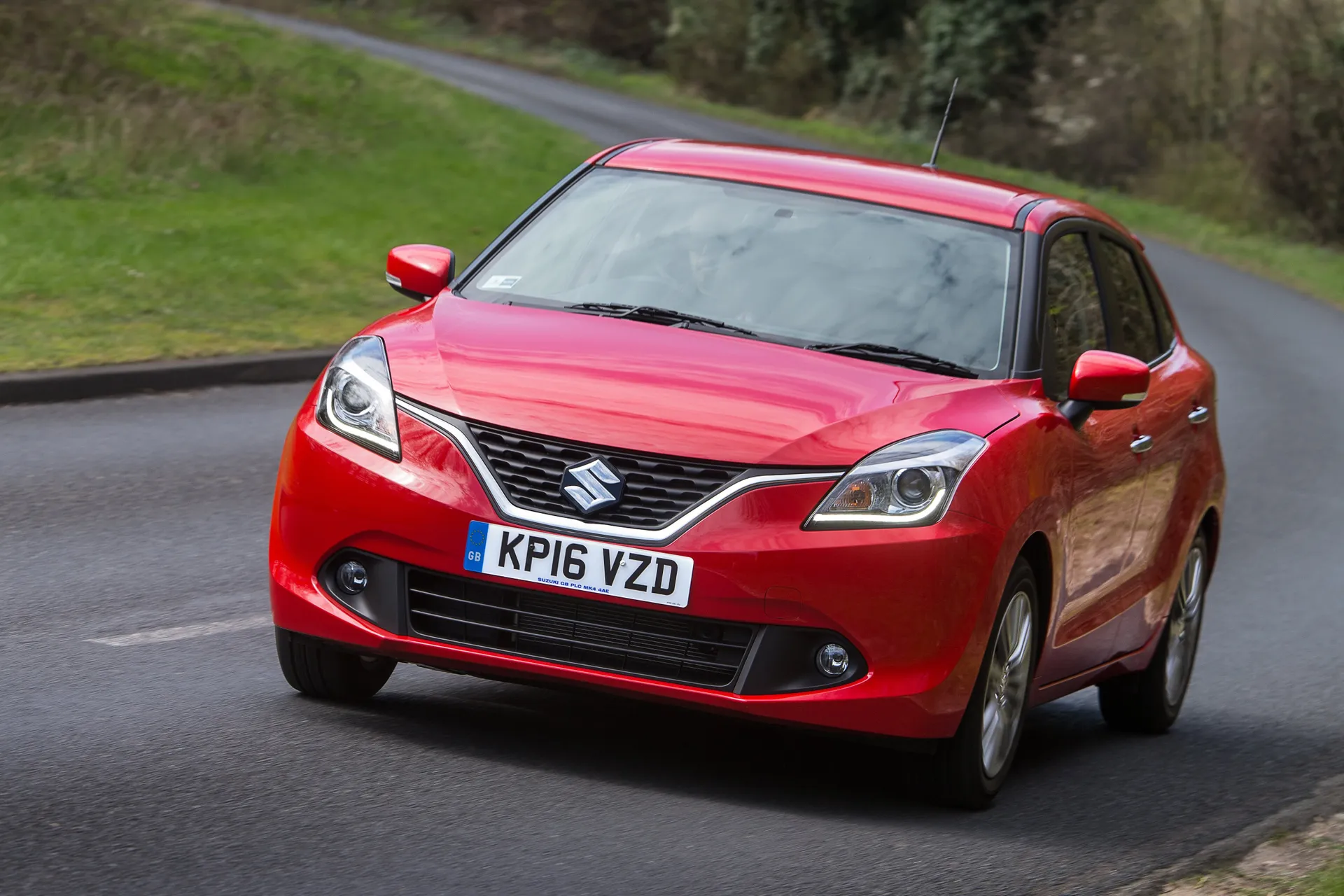
The Suzuki Baleno is an incredibly light car, with most models tipping the scales around 100kg less than the old Suzuki Swift Sport. This helps to give the Baleno a surprising turn of pace. It might not look it, but the Baleno is great fun to drive.
It rides reasonably well, although the soft springs and the overall lightness can result in the car being forced off line by pitted surfaces and even cat’s eyes. You also get a hint of body roll, but there’s never a sense that the tyres are about to lose grip.
In fairness, few Baleno buyers are going to take the car to the ragged edge. This is a purchase driven by rationalism and not emotion. However, it’s good to know that the Baleno isn’t afraid of letting its hair down.
It’s hamstrung by steering that’s not overly communicative, but the lightness makes it easy to manoeuvre and to park.
Overall, the Baleno does a very good job of blending comfort and ride quality. There are no needless driving modes or settings to scroll through. It’s simply a pleasant car to drive, but with enough in its locker to offer a good time should the road open up.
As fun to drive as the Suzuki Swift? Perhaps not, although a Baleno powered by a 1.0-litre Boosterjet engine runs it very close.
We should point out that in order to save weight, Suzuki has given the Baleno a tiny 37-litre fuel tank. This means you’ll be filling up with petrol more often than you think.
Engines and gearboxes
The 1.0-litre Boosterjet engine is a peach and one of the reasons why the Baleno is such an underrated car. The turbocharged three-cylinder unit produces 111PS to deliver a 0-62mph time of 11.4 seconds in the manual version. This might not seem that quick, but it feels much faster in reality.
You also get 170Nm of torque in the manual version, although this drops to 160Nm if you opt for the automatic. This lowers the top speed from 124mph to 118mph, but also shaves 0.4 seconds off the 0-62mph time. The automatic transmission is very good, but the manual gearbox will ensure you get the best from the Boosterjet engine. It’s just a shame that the gearbox is a little vague and stodgy.
The 1.2-litre Dualjet engine is available in standard form or as a mild hybrid. You get the same 90PS and 120Nm of torque in both versions, but the SHVS improves the efficiency. The 0-62mph time of 12.3 seconds and top speed of 111mph are the same for both versions.
The mild hybrid tag is a bit of a red herring, because you can’t drive anywhere using electric power. Instead, it’s more of an integrated starter motor, which is used for smooth and quiet engine restarts. The standard starter motor is used when starting from cold.
You won’t know the SHVS motor is there unless you look under the passenger seat, but you will notice a small increase in fuel efficiency.
Refinement and noise levels
The Boosterjet engine might be fun, but it doesn’t offer the last word in refinement. You get the familiar rumble of the three-cylinder engine, which some buyers love, but others hate with a passion.
It’s fair to say that it sounds noisy when you push it hard, but the engine note gives the Baleno a little character and charm. Besides, the turbocharger means that you don’t have to push it to make swift progress and it soon settles down when up to speed.
The non-turbocharged engine has to be worked hard, which makes it sound coarse and strained, while putting a dent in the fuel economy. It’s also a little flat at low revs, which is another reason why we’d opt for the 1.0-litre Boosterjet.
You also get a fair amount of wind and road noise, while the car’s lightness means that it tends to move around in high winds. It’s not as bad as the Suzuki Ignis in this regard, but it’s definitely noticeable. The lightness also means the Baleno can be thrown off course if you hit a pothole, which can be a little unnerving if it happens while cornering.
Safety equipment
The Suzuki Baleno was one of the first cars to be crash-tested using the Euro NCAP Dual Rating system. From 2016, Euro NCAP has offered manufacturers the opportunity for a car to be awarded two ratings: one based on the standard safety equipment, and the other for a car fitted with an optional ‘safety pack’.
As a result, the standard Baleno gets a three-star safety rating, while the top trim level boasts four stars. Both versions were awarded 73 percent for child occupant protection and 65 percent for pedestrian safety.
However, the standard car scored 80 percent for adult occupant protection and 25 percent for safety assist systems. In the top trim, these figures increased to 85 percent and 43 percent respectively.
The key difference is that the top trim boasts adaptive cruise control and radar brake support. These are optional on the other trim levels.
All versions of the Suzuki Baleno get front, side and curtain airbags on the driver and passenger side, electronic stability control, a tyre pressure monitoring system, Isofix points in the rear, and an emergency flat tyre repair kit. A reversing camera is standard on all except the entry-level version.
The basic Baleno also goes without HID projector headlights, which are superior to the standard versions.
MPG and fuel costs
"In 2017, the Suzuki Baleno was voted the ‘Best Real MPG Performer’ at the Honest John awards. Using true fuel economy from readers, the Baleno recorded an on-the-road economy averaging 99 percent of its advertised figure. Overall, a typical driver should achieve 59.3mpg from the Baleno."
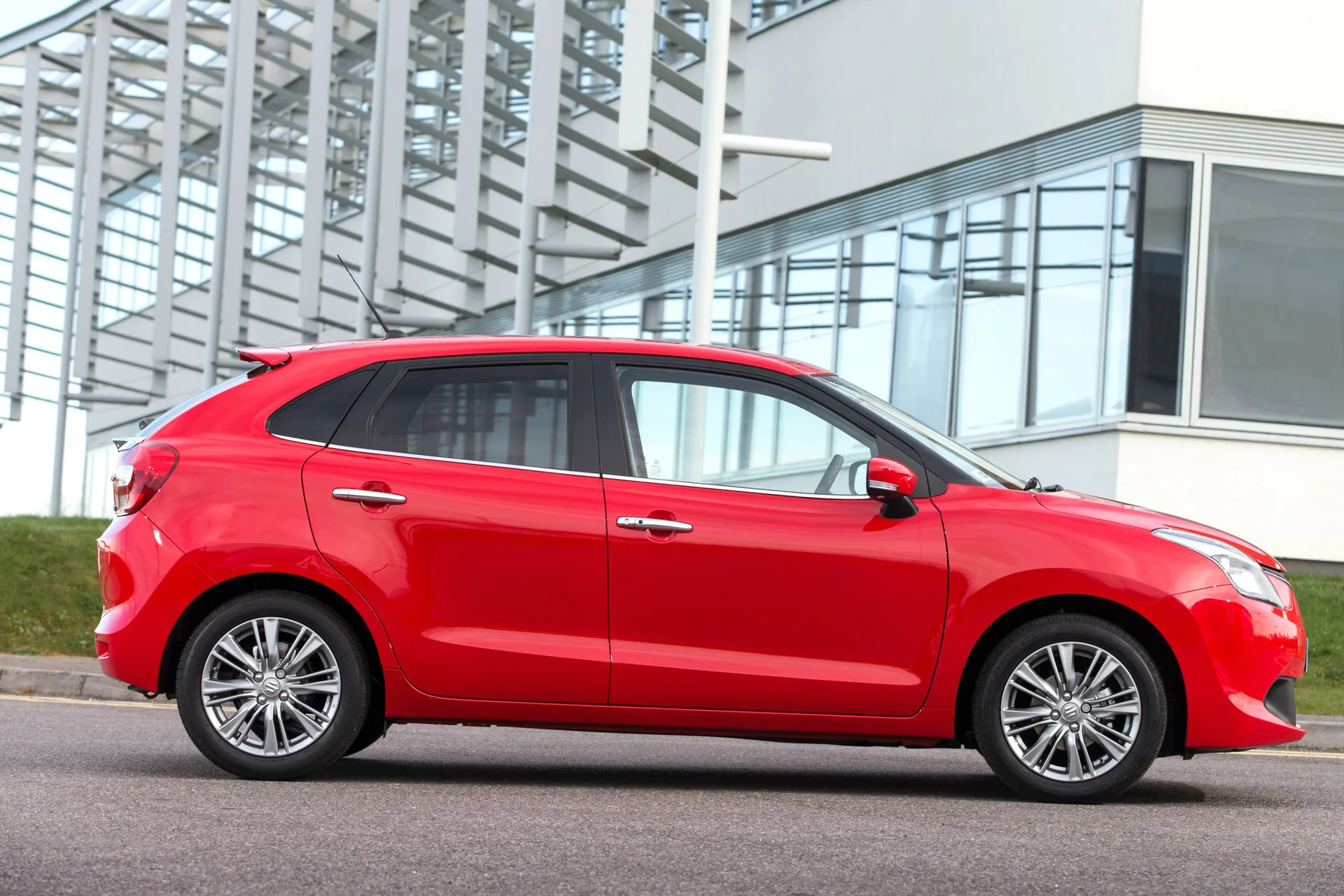
In 2017, the Suzuki Baleno was voted the ‘Best Real MPG Performer’ at the Honest John awards. Using true fuel economy from readers, the Baleno recorded an on-the-road economy averaging 99 percent of its advertised figure. Overall, a typical driver should achieve 59.3mpg from the Baleno.
The 1.2-litre Dualjet SHVS is likely to be the most economical, with Suzuki quoting a claimed 70.6mpg on a combined cycle. This drops to 67.3mpg in the 1.2-litre engine without the mild hybrid tech.
You could see 64.2mpg in the 1.0-litre Boosterjet, but opting for the automatic version will put a 4mpg dent in the economy.
Insurance groups and costs
Thanks to relatively high insurance groups, the Suzuki Baleno isn’t the cheapest car to insure. For example, the 1.0-litre Boosterjet slots into group 16 in SZ-T trim. The extra safety kit on the SZ5 means that the group rating drops to 14, which could save you a few quid a year.
The 1.2-litre Dualjet SHVS slots into group 11, making it the most affordable Baleno to insure. The SZ3 gets a group 13 rating.
For some context, the group ratings for the Ford Fiesta range from two to 16, if we exclude the ST hot hatchback.
VED car tax
Buy a Suzuki Baleno registered on or after 1 April 2017 and you’ll pay £150 in Vehicle Excise Duty (VED).
For cars registered on or before 31 March 2017, the rate varies according to the CO2 emissions. Running a Baleno with a 1.2-litre Dualjet SHVS engine makes a lot of sense, because CO2 emissions of 93g/km mean you’ll pay nothing in VED.
The 1.2-litre Dualjet engine without the mild hybrid tech adds 5g/km to the CO2 emissions, but the Baleno remains tax-exempt.
Thanks to CO2 emissions of 103g/km for the manual and 109g/km for the automatic, the 1.0-litre Boosterjet creeps into band ‘B’. This means you’ll pay £20 a year.
How much should you be paying for a used Suzuki Baleno?
"Because the Suzuki Baleno was such an affordable car when new, there are some seriously tempting low prices on the second-hand market. Early examples start from around £6,000, but we’ve seen some cars on sale for as little as £5,000. For such a spacious and relatively new supermini, that’s exceptional value for money."
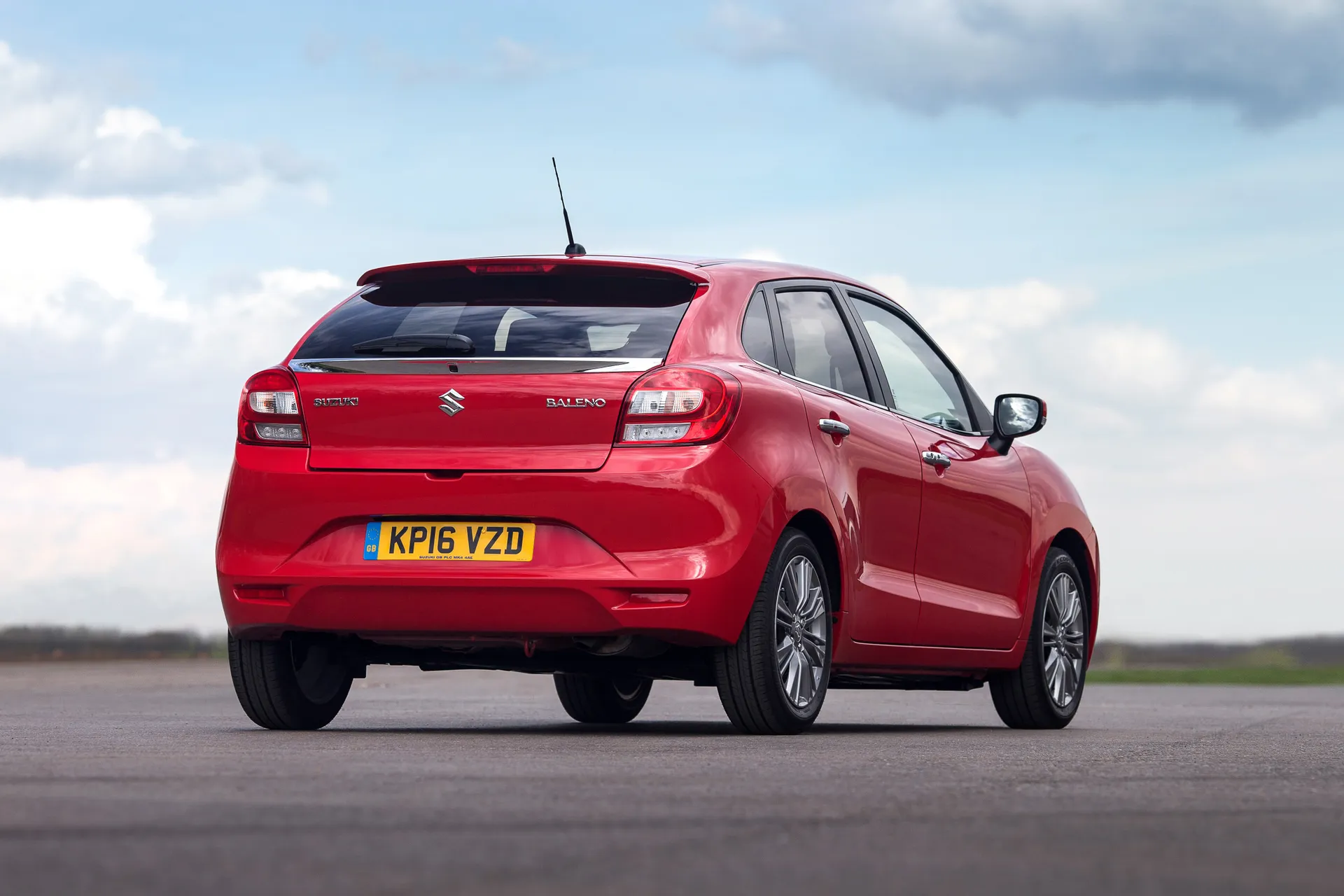
Because the Suzuki Baleno was such an affordable car when new, there are some seriously tempting low prices on the second-hand market. Early examples start from around £6,000, but we’ve seen some cars on sale for as little as £5,000. For such a spacious and relatively new supermini, that’s exceptional value for money.
Buying a car registered later than 2017 will ensure you benefit from the remainder of Suzuki’s three-year warranty. Prices start from around £6,500.
We’d avoid the entry-level SZ3 model, which was introduced after the car launched in 2015. The specification means that it feels one step up from a basic rental car, so it makes sense to upgrade to the SZ-T or SZ5.
The most you’ll pay for a Suzuki Baleno is £11,000. For this price you’ll get a car on a 19-plate with up to 10,000 miles on the clock. Given the space and specification, this could be a worthy alternative to a new Ford Fiesta.
Trim levels and standard equipment
There are three trim levels available in the UK, with the entry-level SZ-T arriving after the Baleno was launched in 2015. It’s a pretty basic affair, featuring 15-inch steel wheels, a CD player, manual air conditioning, Bluetooth, DAB digital radio, front electric windows and LED daytime running lights. It’s easy to spot, thanks to its standard headlights and daytime running lights in the bumper.
The mid-range SZ-T trim boasts HID projector headlights including LED daytime running lights, a touchscreen infotainment system, rear privacy glass, satellite navigation, a reversing camera, front fog lights and 16-inch alloy wheels.
At the top of the tree, the flagship SZ5 model features automatic climate control, adaptive cruise control, radar brake support, rear electric windows, a 4.2-inch colour trip display, full LED rear lights and keyless entry with engine start button.
Because the Suzuki Baleno was on sale for a short time, your options are limited, but we’d avoid the SZ-3 trim.
Get our latest advice, news and offers
Keep me updated by email with the latest advice, news and offers from heycar.
By submitting you agree to our privacy policy
